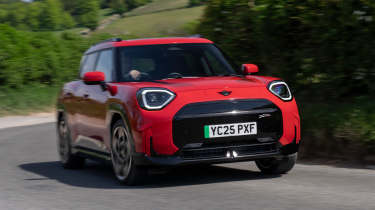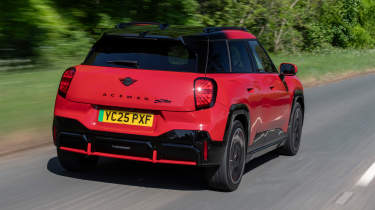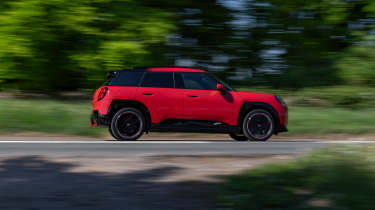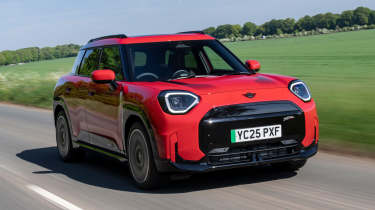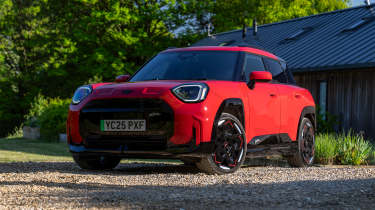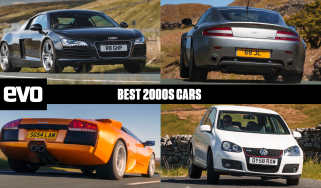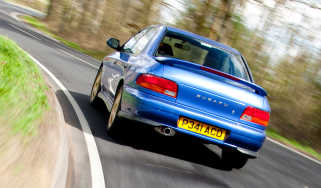Mini Aceman JCW 2025 review – jacked-up 254bhp hot hatch aims at Abarth’s 600e
Mini has given its Aceman crossover the JCW treatment, with a specially-tuned chassis and a 254bhp motor up front. It's fun at times, but fundamentally compromised
Five-door Mini hatchbacks look weird. There’s something uncanny about them, as if they’re a quick cut-and-shut photoshop render brought to life. But they do open up the Mini to a wider audience by being noticeably more spacious and versatile, so sticking with the theme of upsizing, Mini has created the Aceman – a compact crossover that promises to deliver all of Mini’s usual design appeal and character in a more family-friendly package. One that’s also available as an Abarth 600e-rivalling jumbo hot hatch in JCW form, as tested here.
The Aceman is EV-only and closely related to the battery-powered Mini hatch (which you can’t have as a five-door), underpinned by a bespoke platform designed specifically for electric Minis. The firm says it’s a modern interpretation of the innovative packaging that defined the original Mini, but the reality is more conventional with an electric motor up front, a skateboard battery in the floor and rear seats that are just about big enough for tall adults. It’s certainly more roomy than a Mini five-door, but best thought of as an alternative to a hatchback rather than a truly practical crossover.
With the JCW treatment it becomes a sharpened up, 254bhp EV with genuine hot hatch pace, borrowing its innards from Mini’s three-door electric JCW. That’s a car that shows flashes of fun and entertainment in the right conditions, but is compromised by a relentlessly firm ride and a tetchy, hyper alert character that can become wearing. Not what you want from a daily performance car, but does the Aceman use the same ingredients to better effect?
Powertrain and technical highlights
The Aceman is an EV through and through, built on a bespoke new platform that you’ll also find beneath Mini’s latest electric hatch. It’s completely distinct from remaining ICE Minis and thus allows more efficient packaging with a battery under the floor and a single electric motor driving the front wheels. The Aceman JCW gets the same 54.2kWh pack (of which 49.2kWh is usable) as the JCW hatch, as well as its 254bhp, 251lb ft motor. That maximum power figure comes by way of a boost mode, activated using a paddle on the steering wheel.
More reviews
Group tests
- Alpine A290 v Alpine A110 – how much DNA do they really share?
- Ariel Atom 4R v Caterham Seven ‘evo25’: power-to-weight heroes go head-to-head
- Ariel Atom 4 v Caterham Seven 310R v Lotus Elise Cup 250
- £200,000 supercar shoot-out: AMG v Aston Martin v Maserati v McLaren
- Who makes the best GT car? Aston Martin v Bentley v Maserati
- Caterham Super Seven 600 v Super Seven 2000
- Corvette Stingray v Porsche Cayman GTS v Audi R8 RWD
- Volkswagen Golf GTI Clubsport v Cupra Leon 300 – what's the best mainstream hot hatch?
- Great Ferrari hypercars driven: 288 GTO, F40, F50 and Enzo head-to-head
- GMA T.50 v McLaren F1 – has the best car in the world been dethroned by its successor?
In-depth reviews
- Abarth 600e 2025 review – Italy gives the Alpine A290 something to worry about
- Alpine A110 2025 review – an all-time great sports car living on borrowed time
- Aston Martin Vantage 2025 review – a thrilling Mercedes-AMG GT and 911 Turbo S alternative
- Audi R8 (2015 - 2024) review – the ultimate soft-focus supercar
- BMW iX 2025 review – the ugly duckling still stomps the Tesla Model X
Long term tests
- Abarth 695C Turismo Fast Fleet test – 10,000 miles in the Italian hot hatch
- Alfa Romeo Giulia Veloce Fast Fleet test – living with the sharp Italian saloon
- Alpina B10: end of term report
- Alpina B10
- Aston Martin Vantage (2006) Fast Fleet test – living with a £30k V8 Aston
- Caterham Seven evo25 Fast Fleet test – living with a track car for the road
- Caterham Seven evo Edition revealed – bespoke 420R joins the Fast Fleet
- Cupra Leon Estate 310 4Drive Fast Fleet test – living with the 306bhp hot estate
- Ford Mustang GT
- Ford Mustang GT
Review
- New Bentley Batur 2023 review – can it possibly be worth £1.65m?
- 2023 Chevrolet Corvette C8 Z06 review – the American 911 GT3?
- BBR Supercharged Mazda MX-5 (ND) 2023 review – tuned 250bhp roadster driven
- MG4 Trophy 2023 review
Reviews
- Abarth 695 75 Anniversario edition 2024 review – a fitting send-off for Abarth’s hot supermini?
- Abarth 500e 2023 review
- AC Cobra 378 Superblower MkIV 2021 review – another V8 Cobra, but with a GM heart this time
- Acura Integra Type S 2024 review – a Honda Civic Type R with added restraint
- Alfa Romeo Giulia 2025 review – get one while you still can
- Alfa Romeo 33 Stradale 2025 review – a rare Italian jewel beyond compare
- Alfa Romeo SZ: history, review and specs of an icon
The JCW’s character can be altered via a plethora of driving modes (Experience Modes, in Mini speak), which include configurable settings for the powertrain response, steering weight and DSC. A specially-tuned chassis and 19-inch wheels with performance tyres (our test car was on Hankook evo Rs) come as standard, and though the Aceman isn’t exactly mini, it’s still compact – almost identical to the hatch in width and 221mm longer, stretching to 4.08 metres. Somehow, Mini has managed to pack a 1745kg kerbweight into that footprint, making the Aceman almost 100kg heavier than its already-chunky three-door relative.
Performance, ride and handling
The Aceman doesn’t get off to the best start. Where you’d normally expect to sit low and cocooned in a Mini, even a jacked up one, you sit really high in the Aceman’s cabin, the wheel set low and too far away from you. The wheel itself is the same thick-rimmed item fitted to other Minis, and it’s far too bulky to hold, almost making it feel like you’re driving with gloves on.
But while the driving position doesn’t feel like that of a traditional Mini, the dynamics are immediately familiar. The Aceman has the same sharp, always-on feel as other modern Minis with a firm, connected ride and quick steering to give it a sense of agility and fun. It’s not as unyielding as the JCW hatch (not much is), but this still isn’t a car that settles into a flow and works with the surface, and there’s a constant, wound-up tension that jostles you around over bumps and imperfections. It feels like a solid unit and doesn’t crash or rattle horribly, but given its brief as a family-oriented crossover (albeit a hot one) the Aceman ought to have more bandwidth.
That 254bhp front motor pulls the Aceman along nicely. It’s not as spritely as the lighter JCW hatch, and far from as potent as the 429bhp MG4 XPower, but the power gives the front wheels plenty to think about and whisks the car briskly up to motorway speeds. 0-62mph takes an Alpine A290-matching 6.4sec, with top speed pegged at 124mph. Ordinary numbers in the context of today’s hot EVs, but about right for a small, fast crossover.
Switch to Go Kart mode, turn off the DSC and you have full access to that power without electronics to reign it in, and things become quite frantic. The Aceman torque steers severely on a bumpy road, even once up to decent speed, dragging itself across the road and requiring a firm grip on the wheel to stay on course. It’s charming to an extent, reminiscent of a proper hot hatch, but there’s too much to manage when you just want to make neat, fast progress. Add in flares of wheelspin under hard throttle at low speed and you have a lively, frenetic driving experience that’s in some ways a refreshing change from point-and-shoot four-wheel drive EVs, but mostly makes you wish the Aceman would just calm down a bit.
When the tarmac smoothes out the JCW settles down, and you start to appreciate the sense of fun Mini has tried to engineer into it. The quick rack hooks the nose in keenly and you can point the Aceman from corner to corner with small inputs, modulating the power on the way out to keep the front tyres near the edge of slip. With more speed and aggression all that mass starts working the tyres harder, the Aceman not feeling as flat and eager as the JCW hatch, but it’s a surprisingly playful car. Drive it like a proper hot hatch by turning in on the brakes or sharply backing off mid-corner and the rear sweeps around, sometimes requiring a quick flick of opposite lock. It’s not light on its feet and doesn’t move with the deftness of an Alpine A290, but it’s not a dull, safe and steady crossover either.
With that said, the JCW hasn’t got its priorities quite right – yes, it can be fun on the right road, but it doesn’t pull off the trick of having a dual character when you want to make calm, effortless progress. It’s too busy, too firm and too compromised for what should be a usable, daily crossover.
Range and charging
The Aceman gets 243 miles of range from its 54.2kWh battery, which is eight miles less than the JCW hatch but 36 more than the Abarth 600e, and 43 more than Alfa Romeo’s (admittedly more powerful) Junior Veloce.
Charging performance isn’t spectacular, with peak speeds of 95kW, but that’s about on par with rivals from Abarth and Alfa. It’s also enough to top up the battery from 10-80 per cent in less than half an hour, and the Aceman’s sat-nav can precondition the battery before reaching a station to reduce charging time. There’s also the option to set a home charging schedule, which can set a target battery capacity before departure.
Interior and technology
The Aceman’s cabin is one of the best bits about it, thoroughly modern with interesting design details and materials throughout. There’s fabric trim across the dash and door panels, ambient lighting patterns projected in front of you and classic Mini cues, including toggle switches and a big, circular display front and centre. It’s the same OLED touchscreen you’ll find in other new Minis, which handles most major functions – including the climate controls. Graphics are very crisp and the system is responsive, but the UI isn’t the most intuitive, pulling your eyes off the road to decipher the various icons and submenus on-screen.
Unsurprisingly, the Aceman is noticeably roomier than a Mini hatch, with six-foot adults just about being able to squeeze in the back. The boot is bigger too at 300 litres, but still down on the Abarth 600e and Alfa Junior. Overall the Aceman feels more special than just about any small car inside, but it’s worth noting that the JCW only comes with a gloomy black and red colour scheme – lesser Acemans are available with a selection of lighter-coloured upholstery options, which some will find easier on the eye.
Price and rivals
At just under £37,000 the Aceman JCW is around £1500 more than the related JCW hatch, which is reasonable given the extra versatility on offer. It’s also more than £5k cheaper than Alfa Romeo’s Junior Veloce, which has more power (276bhp), fun handling but can’t match the Aceman’s range. Abarth’s 600e matches the Mini on price, packs similar performance but also offers a shorter range.
If you don’t need a jacked up crossover, Alpine’s A290 is currently our favourite electric hatch, even if it’s a warm rather than truly hot one. You can buy the 217bhp A290 GT Performance for a grand less than the JCW.

